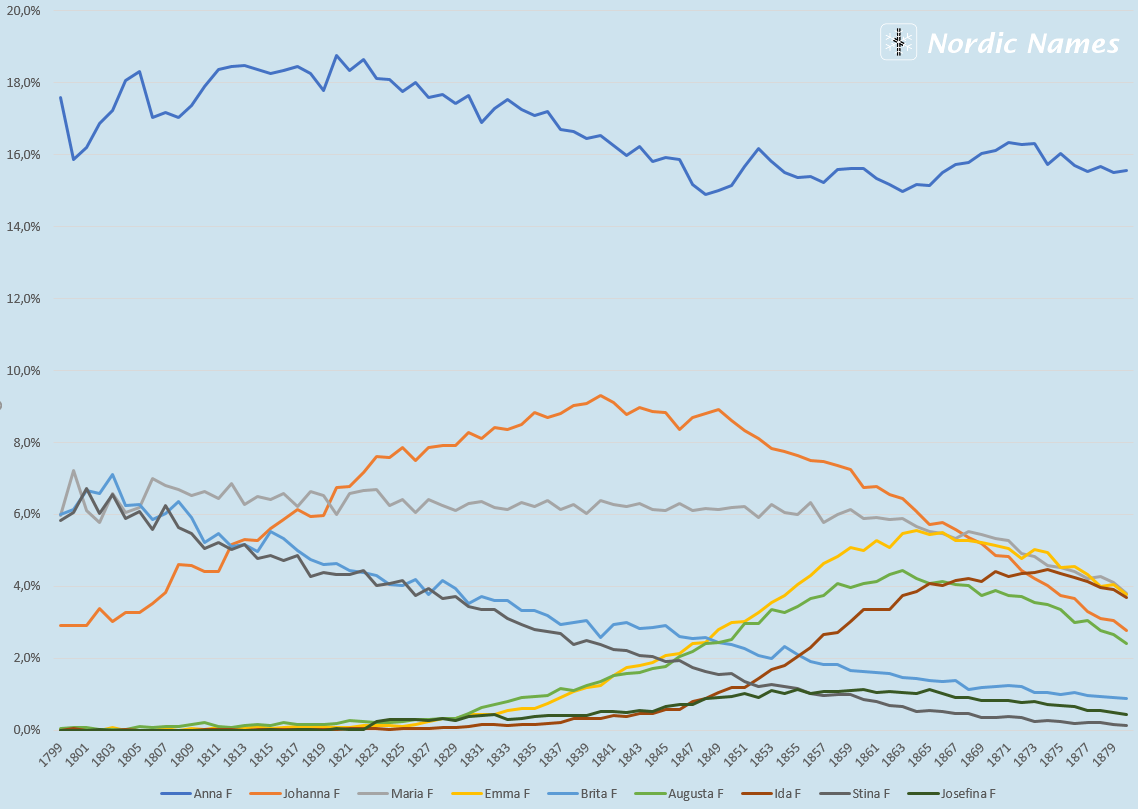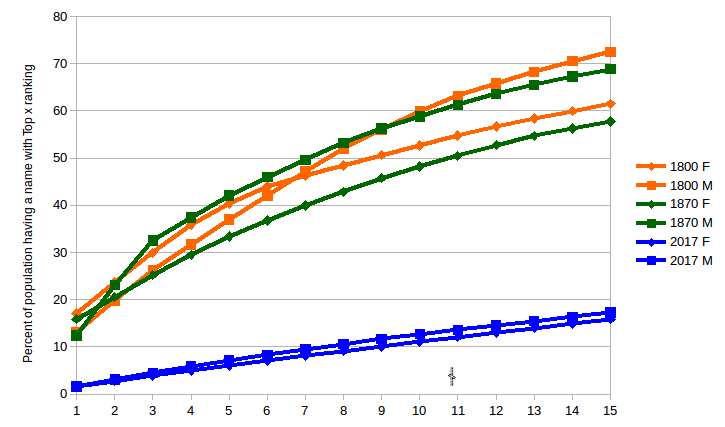Swedish Statistics of 1800 Background
The Swedish name statistics for 1800 to 1880 is our own evaluation of name data of the Swedish Census of 1880. The census gives quite a good overview of the names of people living in Sweden in the 19th Century. The data covers up to 80 % of people born in the decade 1870 to 1879 down to 16 % for the oldest evaluated decade 1800 to 1809. The reason for the decreasing coverage for older ages are both fatalities as well as emigration.
Contents
Method of evaluation
- We have only evaluated the first given name for name statistics
- Different spelling variants have not been adjusted, hence counting Karl and Carl as different names, also reflecting different spellings at different times.
- We have evaluated the gender balance for the different decades and taken it into account for the statistics projections: between about 50/50 for young ages up to 60/40 female/male for the oldest decade.
Statistics based on this evaluation
- Swedish Statistics of 1800-1809
- Swedish Statistics of 1810-1819
- Swedish Statistics of 1820-1829
- Swedish Statistics of 1830-1839
- Swedish Statistics of 1840-1849
- Swedish Statistics of 1850-1859
- Swedish Statistics of 1860-1869
- Swedish Statistics of 1870-1879
Statistic Trends
Even during the 18th century, some names became popular over time while others decreased in popularity. This is well visible over the evaluation period of 80 years, here shown for some common girls' names:

Notably, Anna has been the most prominent first name of the 19th century, with about 16 % of the girls named Anna, each throughout the complete evaluation period. 16 % means one out of six girls was named Anna, which is far more common than even the most popular first names of today.
 Overall, the variation of first names was much smaller than it is today. The chart above illustrates the percentage of population which has a first name within the top x ranking at different points of time, around 1800, around 1870 and today (2017). E.g. for the male population, 50% of the people had a name within the top 8 most common names in the 19th century. The female names had a slightly larger overall variation, but also a higher concentration around the top 1 name, Anna.
Below depicted in blue for comparison is the name distribution today showing a much higher variability, only about 12% of persons have a name within the top 10 of common names.
Overall, the variation of first names was much smaller than it is today. The chart above illustrates the percentage of population which has a first name within the top x ranking at different points of time, around 1800, around 1870 and today (2017). E.g. for the male population, 50% of the people had a name within the top 8 most common names in the 19th century. The female names had a slightly larger overall variation, but also a higher concentration around the top 1 name, Anna.
Below depicted in blue for comparison is the name distribution today showing a much higher variability, only about 12% of persons have a name within the top 10 of common names.
Some other findings during evaluation
- Primary patronyms are still used throughout the data set, i.e. the son of Jan is called Jansson instead of using a family name
- Common family names are not widely used. I.e. the daughter of Per is recorded as Persdotter even when married.
- Even Secondary Patronyms occur throughout the data set. Already in 1800, about 10% of the women called Anna do have a -son family name, while primary patronymic family names would end in -dotter.
- Children have been been recorded without own family name while still living in their parents' households.
- Also descriptive properties have been recorded as part of the first names. However, they are typically not used as only first name and they are used for both genders. While evaluating the first given names the the following forms have been noted, each present at least 100 times in the data set:
- based on heritage, using a genitive form of a given name, such as Knuts, Lasses, Pers, Daniels
- based on profession: Skräddar ('tailor'), Klockar ('ringer')
- based on a farm name: Nygårds
 Name Finder
Name Finder Browse Name List
Browse Name List Random Names
Random Names Danish Names
Danish Names Faroese Names
Faroese Names Finnish Names
Finnish Names Greenlandic Names
Greenlandic Names Icelandic Names
Icelandic Names Norwegian Names
Norwegian Names Sami Names
Sami Names Swedish Names
Swedish Names More Nordic Names
More Nordic Names Bibliography
Bibliography





